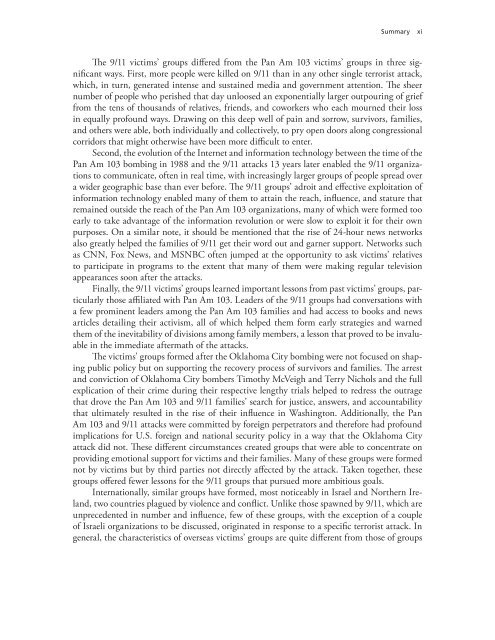The Victims of Terrorism: An Assessment of Their Influence and ...
The Victims of Terrorism: An Assessment of Their Influence and ...
The Victims of Terrorism: An Assessment of Their Influence and ...
You also want an ePaper? Increase the reach of your titles
YUMPU automatically turns print PDFs into web optimized ePapers that Google loves.
Summaryxi<strong>The</strong> 9/11 victims’ groups differed from the Pan Am 103 victims’ groups in three significantways. First, more people were killed on 9/11 than in any other single terrorist attack,which, in turn, generated intense <strong>and</strong> sustained media <strong>and</strong> government attention. <strong>The</strong> sheernumber <strong>of</strong> people who perished that day unloosed an exponentially larger outpouring <strong>of</strong> grieffrom the tens <strong>of</strong> thous<strong>and</strong>s <strong>of</strong> relatives, friends, <strong>and</strong> coworkers who each mourned their lossin equally pr<strong>of</strong>ound ways. Drawing on this deep well <strong>of</strong> pain <strong>and</strong> sorrow, survivors, families,<strong>and</strong> others were able, both individually <strong>and</strong> collectively, to pry open doors along congressionalcorridors that might otherwise have been more difficult to enter.Second, the evolution <strong>of</strong> the Internet <strong>and</strong> information technology between the time <strong>of</strong> thePan Am 103 bombing in 1988 <strong>and</strong> the 9/11 attacks 13 years later enabled the 9/11 organizationsto communicate, <strong>of</strong>ten in real time, with increasingly larger groups <strong>of</strong> people spread overa wider geographic base than ever before. <strong>The</strong> 9/11 groups’ adroit <strong>and</strong> effective exploitation <strong>of</strong>information technology enabled many <strong>of</strong> them to attain the reach, influence, <strong>and</strong> stature thatremained outside the reach <strong>of</strong> the Pan Am 103 organizations, many <strong>of</strong> which were formed tooearly to take advantage <strong>of</strong> the information revolution or were slow to exploit it for their ownpurposes. On a similar note, it should be mentioned that the rise <strong>of</strong> 24-hour news networksalso greatly helped the families <strong>of</strong> 9/11 get their word out <strong>and</strong> garner support. Networks suchas CNN, Fox News, <strong>and</strong> MSNBC <strong>of</strong>ten jumped at the opportunity to ask victims’ relativesto participate in programs to the extent that many <strong>of</strong> them were making regular televisionappearances soon after the attacks.Finally, the 9/11 victims’ groups learned important lessons from past victims’ groups, particularlythose affiliated with Pan Am 103. Leaders <strong>of</strong> the 9/11 groups had conversations witha few prominent leaders among the Pan Am 103 families <strong>and</strong> had access to books <strong>and</strong> newsarticles detailing their activism, all <strong>of</strong> which helped them form early strategies <strong>and</strong> warnedthem <strong>of</strong> the inevitability <strong>of</strong> divisions among family members, a lesson that proved to be invaluablein the immediate aftermath <strong>of</strong> the attacks.<strong>The</strong> victims’ groups formed after the Oklahoma City bombing were not focused on shapingpublic policy but on supporting the recovery process <strong>of</strong> survivors <strong>and</strong> families. <strong>The</strong> arrest<strong>and</strong> conviction <strong>of</strong> Oklahoma City bombers Timothy McVeigh <strong>and</strong> Terry Nichols <strong>and</strong> the fullexplication <strong>of</strong> their crime during their respective lengthy trials helped to redress the outragethat drove the Pan Am 103 <strong>and</strong> 9/11 families’ search for justice, answers, <strong>and</strong> accountabilitythat ultimately resulted in the rise <strong>of</strong> their influence in Washington. Additionally, the PanAm 103 <strong>and</strong> 9/11 attacks were committed by foreign perpetrators <strong>and</strong> therefore had pr<strong>of</strong>oundimplications for U.S. foreign <strong>and</strong> national security policy in a way that the Oklahoma Cityattack did not. <strong>The</strong>se different circumstances created groups that were able to concentrate onproviding emotional support for victims <strong>and</strong> their families. Many <strong>of</strong> these groups were formednot by victims but by third parties not directly affected by the attack. Taken together, thesegroups <strong>of</strong>fered fewer lessons for the 9/11 groups that pursued more ambitious goals.Internationally, similar groups have formed, most noticeably in Israel <strong>and</strong> Northern Irel<strong>and</strong>,two countries plagued by violence <strong>and</strong> conflict. Unlike those spawned by 9/11, which areunprecedented in number <strong>and</strong> influence, few <strong>of</strong> these groups, with the exception <strong>of</strong> a couple<strong>of</strong> Israeli organizations to be discussed, originated in response to a specific terrorist attack. Ingeneral, the characteristics <strong>of</strong> overseas victims’ groups are quite different from those <strong>of</strong> groups
















